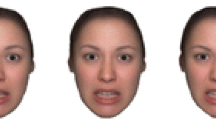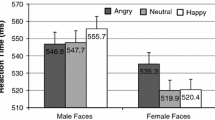Abstract
The present study examined the impact of conflict over emotional expression on the nonverbal communication process between romantic partners. Fifty-four romantically involved female undergraduate students who scored within the upper or lower 30th percentile range on the Ambivalence over the Expression of Emotion Questionnaire (AEQ; King & Emmons, 1990) were recruited along with their romantic partners. The facial expressions of these women were examined during a conflict resolution task. Analyses indicated that highly ambivalent women expressed a greater number of negative facial expressions and shorter lasting positive facial expressions (measured with FACES; Kring & Sloan, 1992) than less ambivalent women. These expressions were not entirely explained by current mood, as ambivalence predicted a greater number of negative facial expressions, and a briefer display of positive facial expressions, above and beyond current levels of negative and positive affect. Furthermore, analyses indicated that the number of women's negative expressions predicted significant increases in men's dysphoria and marginal increases in men's anxiety, suggesting potential negative interactional patterns between ambivalent women and their partners.
Similar content being viewed by others
References
Christensen, A. (1988). Dysfunctional interaction patterns in couples. In P. Noller & M. A. Fitzpatrick (Eds.), Perspectives on marital interaction (pp. 31–52). Philadelphia, PA: Multilingual Matters Ltd.
Corcoran, K., & Fischer, J. (1987). Measures for clinical practice: A sourcebook (pp. 443–444). New York: The Free Press.
Coren, S., & Russell, J. A. (1992). The relative dominance of different facial expressions of emotion under conditions of perceptual ambiguity. Cognition and Emotion, 6(5), 339–356.
Earnst, K. S., Kring, A. M., Kadar, M. A., Salem, J. E., Shepard, D., & Loosen, P. T. (1996). Facial expression in schizophrenia. Biological Psychiatry, 40(6), 556–558.
Ekman, P., & Friesen, W. V. (1975). Unmasking the face: A guide to recognizing emotions from facial clues. Englewood Cliffs, NJ: Prentice Hall.
Ekman, P., & Oster, H. (1979). Facial expressions of emotion. Annual Review of Psychology, 30, 527–554.
Emmons, R. A., & Colby, P. M. (1995). Emotional conflict and well-being: Relation to perceived availability, daily utilization, and observer reports of social support. Journal of Personality and Social Psychology, 68(5), 947–959.
Fridlund, A. J. (1994). Human facial expression: An evolutionary view. Toronto, Canada: Academic Press Inc.
Gaelick, L., Bodenhausen, G. V., & Wyer, R. S. (1985). Emotional communication in close relationships. Journal of Personality and Social Psychology, 49, 1246–1265.
Gottman, J. M. (1993). Studying emotion in social interaction. In M. Lewis & J. M. Haviland (Eds.), Handbook of emotions (pp. 475–487). New York: The Guildford Press.
Gottman, J. M., & Levenson, R. W. (1992). Marital processes predictive of later dissolution: Behavior, physiology, and health. Journal of Personality and Social Psychology, 63, 221–233.
Guthrie, D. M., & Snyder, C. W. Jr. (1988). Spouses' self-evaluation for situations involving emotional communication. In P. Noller & M. A. Fitzpatrick (Eds.), Perspectives on marital interaction (pp. 123–152). Philadelphia, PA: Multilingual Matters Ltd.
Hooley, J. M., & Hahlweg, K. (1989). Marital satisfaction and marital communication in German and English couples. Behavioral Assessment, 11, 119–133.
Hudson, W. W. (1982a). A measurement package for clinical workers. The Journal of Applied Behavioral Science, 18(2), 229–238.
Hudson, W. W. (1982b). The clinical measurement package: A field manual. Chicago: Dorsey Press.
Katz, I. M., & Campbell, J. D. (1994). Ambivalence over emotional expression and well-being: Nomothetic and idiographic tests of the stress-buffering hypothesis. Journal of Personality and Social Psychology, 67, 513–524.
King, L. A. (1993). Emotional expression, ambivalence over expression, and marital satisfaction. Journal of Social and Personal Relationships, 10, 601–607.
King, L. A. (1998). Ambivalence over emotional expression and reading emotions in situations and faces. Journal of Personality and Social Psychology, 74(3), 753–762.
King, L. A., & Emmons, R. A. (1990). Conflict over emotional expression: Psychological and physical correlates. Journal of Personality and Social Psychology, 58(5), 864–877.
King, L. A., & Emmons, R. A. (1991). Psychological, physical, and interpersonal correlates of emotional expressiveness, conflict, and control. European Journal of Personality, 5, 131–150.
King, L. A., Emmons, R. A., & Woodley, S. (1992). The structure of inhibition. Journal of Research in Personality, 26, 85–102.
Kring, A. M., Kerr, S. L., Smith, D. A., & Neale, J. M. (1993). Flat affect in schizophrenia does not reflect diminished subjective experience of emotion. Journal of Abnormal Psychology, 102(4), 507–517.
Kring, A. M., & Neale, J. M. (1996). Do schizophrenic patients show a disjunctive relationship among expressive, experiential, and psychophysiological components of emotion? Journal of Abnormal Psychology, 105(2), 249–257.
Kring, A. M., & Sloan, D. (1992). The facial expression coding system (FACES): A users guide. Unpublished.
Marcus, D. K., & Nardone, M. E. (1992). Depression and interpersonal rejection. Clinical Psychology Review, 12, 433–449.
Matsumoto, D., Ekman, P., & Fridlund, A. (1991). Analyzing nonverbal behavior. In P. W. Dowrick (Ed.), Practical guide to using video in the behavioral sciences (pp. 153–165). New York: Wiley.
Mongrain, M., & Vettese, L. C. (April 2003). Conflict over emotional expression: Implications for interpersonal communication. Personality and Social Psychology Bulletin 29, 545–555.
Mongrain, M., & Zuroff, D. C. (1994). Ambivalence over emotional expression and negative life events: Mediators of depressive symptoms in dependent and self-critical individuals. Personality and Individual Differences, 16(3), 447–458.
Russell, J. A., & Carroll, J. M. (1999). On the bipolarity of positive and negative affect. Psychological Bulletin, 125(1), 3–30.
Segrin, C., & Abramson, L. Y. (1994). Negative reactions to depressive behaviors: A communication theories analysis. Journal of Abnormal Psychology, 103(4), 655–668.
Teasdale, J. D., & Fogarty, S. J. (1979). Differential effects of induced mood on retrieval of pleasant and unpleasant events from episodic memory. Journal of Abnormal Psychology, 88(3), 248–257.
Zuroff, D. C., & Duncan, N. (1999). Self-criticism and conflict resolution in romantic couples. Canadian Journal of Behavioural Science, 31(3), 137–149.
Author information
Authors and Affiliations
Corresponding author
Rights and permissions
About this article
Cite this article
Heisel, M.J., Mongrain, M. Facial Expressions and Ambivalence: Looking for Conflict in All the Right Faces. Journal of Nonverbal Behavior 28, 35–52 (2004). https://doi.org/10.1023/B:JONB.0000017866.03983.72
Issue Date:
DOI: https://doi.org/10.1023/B:JONB.0000017866.03983.72




